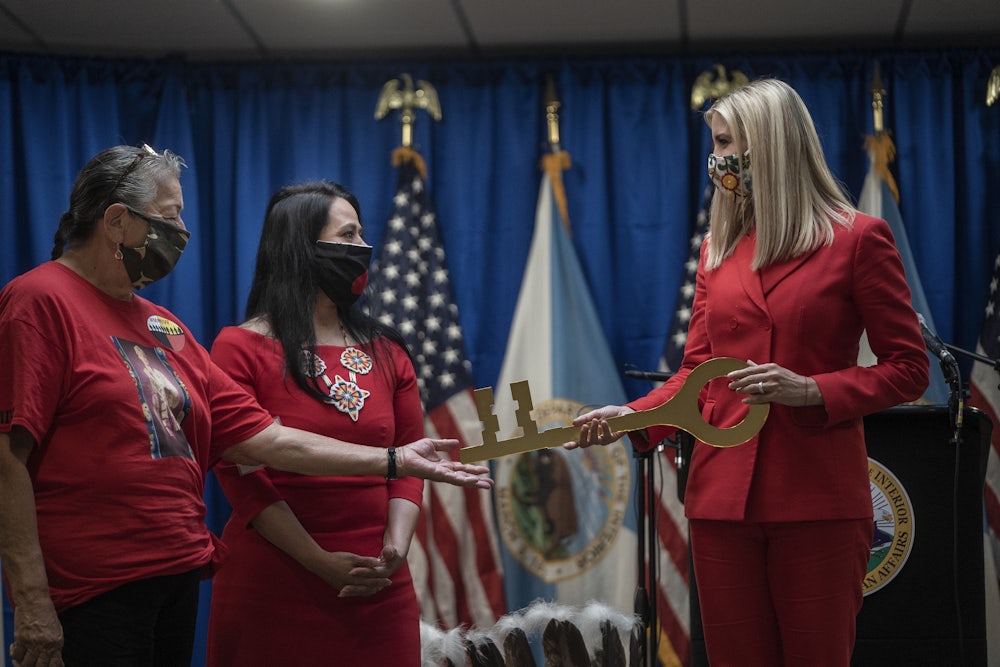The picture tells a nice story: Ivanka Trump—smiling with a big golden key in hand—stands alongside assistant secretary for the Bureau of Indian Affairs Tara Sweeney, Lower Sioux Indian Community Vice President Grace Goldtooth, and Interior Secretary David Bernhardt. They are there to mark the opening of an office in Bloomington, Minnesota, dedicated to cold cases in Indian Country. Specifically, the office is designed to address the Missing and Murdered Indigenous Women and Girls, or MMIWG, crisis, and is one of seven such offices that the Trump administration has said it will open across the country, each the result of an executive order the president signed last November. On its face, it’s an urgent commitment in response to years of federal neglect.
But in typical Trump style, it was little more than a P.R. stunt, just another branding exercise for Ivanka and a weak attempt by the administration to gin up some short-lived goodwill in Indian Country. In response to the empty spectacle, people had gathered in front of the office in protest. Addressing that crowd, Mary Kunesh-Podein, a Democratic-Farmer-Labor Party state representative and Standing Rock Sioux descendant whose mother and maternal grandmother were citizens, described the evening’s event as a “political ploy.” Despite the fanfare around the ceremony and Ivanka’s presence, Kunesh-Podein told The New Republic that she and other elected officials in the state who have been actively working on these issues were not consulted.
“The past four years, there always seemed to be a reluctance or dragging of the feet when it comes to funding or creating programs that are going to help Native Americans,” Kunesh-Podein said. “We have no trust for the Trump administration. So right away, we’re on guard. What is the reason that they’re doing this less than 100 days before the election? It’s one of those: ‘Here’s what we’re going to do for you, you’ve got to thank us by your votes.’ And that’s really what we feel this was all about.”
Kunesh-Podein knows what an actual community-led response looks like. Spurred by the 2017 murder of Spirit Lake Sioux Tribe citizen Savannah Greywind and the 2018 preliminary report from Canada’s MMIWG national inquiry, Kunesh-Podein, who was elected in 2016, crafted and refined a bill to create and fund an MMIWG task force, which would be tasked with presenting the policy program needed for a meaningful response. To make the proposal as comprehensive as possible, she worked with Native women, tribal communities, nonprofits, state agencies, and families of MMIWG victims who had already been working to bring attention to the crisis. The legislation failed to pass the Republican-controlled legislature after she first introduced it in 2018 but passed in 2019 after Democrats flipped the state House. It was signed into law by Minnesota Governor Tim Walz that September.
The Minnesota task force, one of several MMIWG state-led initiatives formed over the past five years, convened its first quarterly meeting last fall. In less than a year’s time, the task force has gone into Minnesota’s Native communities to host a series of listening sessions for MMIWG victims and families, completed consultations with tribal leaders, and organized data from the state’s Department of Public Safety and Department of Justice. Kunesh-Podein told me that it expects to release a report this coming December that will outline its current findings and suggestions for the state.
Kunesh-Podein and others behind the task force, in other words, were the perfect people for the Trump administration to consult as leaders and experts in its own efforts. But that isn’t what happened, according to Kunesh-Podein and Mary Lyons, a White Earth Ojibwe citizen and an adviser for the Minnesota task force. Lyons told Native News Online, “Not one [member] of our Task Force was invited to participate in today’s announcement.” Even Red Lake Nation Chairman Darrel Seki Jr., who canceled his attendance at the event due to a Covid-19 outbreak on his reservation, told the Bloomington-Richfield Sun Current that he was not notified of the event until late last week. “I just found out it’s a campaign trip,” Seki said. “I didn’t know that was going on. I don’t want to be involved with something like that.”
The Minnesota task force was the combined result of Native organizers and grassroots efforts that have repeatedly publicized MMIWG cases and of Native lawmakers like Kunesh-Podein. Last November’s announcement of a national task force from the White House, on the other hand, as Congresswoman Deb Haaland of New Mexico said at the time, “reflects a lack of consultation with Tribes.”
This superficiality is consistent with the rest of the administration’s practices: The Trump administration, while paying lip service to the MMIWG crisis, has simultaneously pushed border walls, pipelines, and mining operations on tribal lands despite the knowledge that temporary man camps from extractive energy projects have been directly tied to the MMIWG crisis. Meanwhile, federal legislation that has been drawn up to specifically address the jurisdictional and data issues that exacerbate the crisis, like the Not Invisible Act and Savanna’s Act (named after Greywind), have languished in Congress. This, combined with the stalled reauthorization of the Violence Against Women Act, which in 2013 was updated to allow tribal courts to charge non-Native abusers, has only created wariness of any Trump-led initiatives.
Kunesh-Podein does retain hope, though that a new administration could take the existing framework of a federal task force and “do it with real integrity and fidelity.” In the meantime, she’s been more focused on helping other states—like Wisconsin—establish MMIWG task forces of their own in the image of Minnesota’s model. It’s here, she says, that the real work is being done. Ivanka Trump can keep her golden key.
